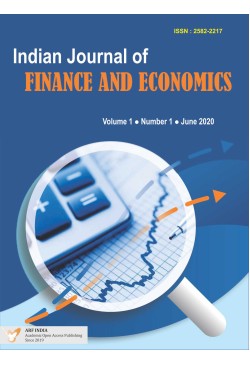
Indian Journal of Finance and Economics
Frequency :Bi-Annual
ISSN :2582-2217
Peer Reviewed Journal
LEVERAGE AND INVESTMENT OF THE INDIAN CORPORATE SECTOR - IS INVESTMENT ON A RECOVERY PATH?
Deba Prasad Rath & Sujeesh Kumar (2023). Leverage and Investment of the Indian Corporate Sector – Is Investment on a Recovery Path?. Indian Journal of Finance and Economics. 4(1), 1-38. https://DOI:10.47509/IJFE.2023.v04i01.01
IDENTIFYING THE FACTORS OF SUPPLY CHAIN MANAGEMENT STRATEGY – A STUDY
Rupak Karmakar (2023). Identifying the Factors of Supply Chain Management Strategy—A Study. Indian Journal of Finance and Economics. 4(1), 39-44. https://DOI:10.47509/IJFE.2023.v04i01.02
TAXATION SYSTEM IN INDIA: A JOURNEY THROUGH THE ROOTS
Taxation is a mark of civilization. Tax evolved and developed independently in the great ancient empires. The concepts that evolved were transported to other empires and cultures where tax ideas took root. This pattern continues through to today as nations are influenced by developments in tax from other countries. Taxes are traced from their roots on through mutations. This analysis traces the evolution of ideas about one of the most important policies facing any country: taxation. The article will demonstrate that elite ideas about tax policy have changed dramatically over the past century and that these ideas have had enormous consequences for the development of the modern income tax Act. You know the saying—nothing is certain except death and taxes. (Franklin, Benjamin Letter to Jean-Baptiste Le Roy, 13 November 1789). While that may be true, taxes tend to be more complicated and very inconsistent. And they didn’t always exist as they do today. will look at history from the manusmriti to India’s today through the prism of tax.We begin this entry by providing an overview of historical changes in taxation patterns, and then move on to discussing recent trends and patterns in taxation around India. The idea is not to enter into an exhaustive discussion of this theme but rather merely to give a chronology of the principal work in the light of the views of leading authorities. This paper is an attempt to give a brief look on the growth and evolution of taxes in India from the ancient times.
Barkha Rani & Deepika Meena (2023). Taxation System in India: A Journey through the Roots. Indian Journal of Finance and Economics. 4(1), 45-51. https://DOI:10.47509/IJFE.2023.v04i01.03
POPULATION AND ECONOMIC GROWTH NEXUS: EMPIRICAL EVIDENCE FROM NIGERIA
Sylvester Onyeoma & Blessing Ose Oligbi (2023). Population and Economic Growth Nexus: Empirical Evidence from Nigeria. Indian Journal of Finance and Economics. 4(1), 53-72. https://DOI:10.47509/IJFE.2023.v04i01.04
EXCHANGE-TRADED FUNDS, HETEROGENEOUS AGENTS, AND FINANCIAL STABILITY
Michael H. Baumann, Michaela Baumann & Bernhard Herz (2023). Exchange-Traded Funds, Heterogeneous Agents, and Financial Stability. Indian Journal of Finance and Economics. 4(1), 73-120. https://DOI:10.47509/IJFE.2023.v04i01.05
INVESTIGATING PUBLIC PERCEPTION AND PARTICIPATION IN WATERSHED MANAGEMENT: A CASE STUDY OF MAHARASHTRA
S.N. Tripathi & Prasanna V. Narayanasamy (2023). Investigating Public Perception and Participation in Watershed Management: A Case Study of Maharashtra. Indian Journal of Finance and Economics. 4(1), 121-147. https://DOI:10.47509/IJFE.2023.v04i01.06
THE IMPACT OF CLIMATE CHANGE ON CROP PRODUCTION IN NIGERIAN ECONOMY
Ozor Patience Lilian (2023). The Impact of Climate Change on Crop Production in Nigerian Economy. Indian Journal of Finance and Economics. 4(1), 149-163. https://DOI:10.47509/IJFE.2023.v04i01.07
IS PUBLIC DEBT AFFECT THE INDIAN ECONOMY
Public debt is one of the most important crises in recent decades not only in India but also World. The role of public debt in the government’s financial position in India and different state governments are a challenging factor. It has a crucial role in the process of economic development. There is a functional relationship between public debt and economic development in positive and negative aspects existence of empirical results indicated. The level of public debt is issued at international, national, and state levels in different countries after the financial crisis in 2008. Whenever increasing public debt is retard investment and economic growth. Repayment of interest rates to public debt is the biggest problem in India. The Union Government has spent one-third of its total revenue on interest payments meant to external and internal sources may be increased. It is the biggest problem for the Government of India and various state governments.
K. Murugan & K. Kalaimani (2023). Is Public Debt affect the Indian Economy. Indian Journal of Finance and Economics. 4(1), 165-191. https://DOI:10.47509/IJFE.2023.v04i01.08
IMPACT OF EXCHANGE RATE AND CRUDE OIL PRICE ON INDIAN STOCK MARKET
Gautam Das (2023). Impact of Exchange Rate and Crude Oil Price on Indian Stock Market. Indian Journal of Finance and Economics. 4(1), 193-203. https://DOI:10.47509/IJFE.2023.v04i01.09
AN ENQUIRY INTO STABILITY AND EFFICIENCY IN INDIAN STOCK MARKET DURING POST REFORMS PERIOD
Triseeta Hazra & Arup Chattopadhyay (2023). An Enquiry into Stability and Efficiency in Indian Stock Market during Post Reforms Period. Indian Journal of Finance and Economics. 4(1), 205-229. https://DOI:10.47509/IJFE.2023.v04i01.10
STATUS OF INCOME AND SAVINGS OF SHGs IN ODISHA – A CASE STUDY OF BHADRAK DISTRICT
Mamata Panda & L. N. Das (2023). Status of Income and Savings of SHGs in Odisha–A Case Study of Bhadrak District. Indian Journal of Finance and Economics. 4(1), 205-229. https://DOI:10.47509/IJFE.2023.v04i01.11